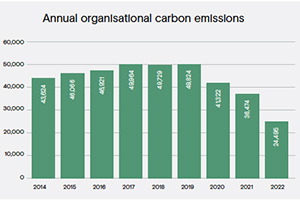Sustainability
- Home
- Locations
- What you can do
- LiFE Framework
- Sustainable Development Goals
- About us
- Grants
- Events
- Contact us
Now searching for:

Charles Sturt’s comprehensive Clean Energy Strategy sets out a pathway for Charles Sturt to be resilient, efficient and ready for a low-carbon future.
In 2022, this plan has significantly delivered on its action to aggressively mitigate climate change by reducing its greenhouse gas emissions (GHGE) by 12,000 tonnes carbon dioxide equivalents (tCO2-e), down to 24,495 tCO2-e. This is equivalent to a reduction of 33 per cent compared to 2021, and a reduction of 44 per cent compared to Charles Sturt’s Base Year reporting (2014).
Avoided emissions in 2022 resulted from the establishment of a Renewable Power Purchase Agreement with Iberdrola Australia for the supply of electricity to Charles Sturt’s large market sites (96.5 per cent of savings), newly commissioned rooftop solar power stations (2.5 per cent) and campus energy efficiency improvements (1 per cent).
In 2022, Charles Sturt’s GHGE attributable to electricity and natural gas emissions was 49 per cent of its total compared to 78 per cent in 2021.
The emission source that experienced the biggest increase in 2022 was travel and accommodation, which has followed the relaxation of travel restrictions following the COVID pandemic. A three-fold increase in emissions was observed in this area.
Charles Sturt purchases and retires carbon offsets equivalent to its organisational carbon footprint as part of its commitment to being a certified carbon neutral organisation under the Climate Active program.
Find out more about
Charles Sturt’s carbon neutral certification